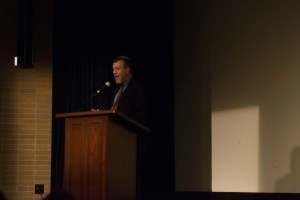Rabbi Dr. Joshua Berman lectured Wednesday night about the differences in ideology and architecture between the Israelites’ tabernacle and Solomon’s temple.
Berman began by explaining that biblical figures usually proclaimed God’s name only when they were successful. They understood that was when people would be more likely to listen to their message.

“Abraham proclaimed the name or reputation of the Lord,” Berman said. “But only when he was on the top of his game.”
He explained that it was similar for the people who carried the tabernacle and built the temple.
Berman called the tabernacle an “Ikea-style temple” and said the children of Israel were not always strong enough for God to let them build a temple. They waited 500 years to build a true temple because that is how long it took them to build their nation.
“If the real purpose of a temple is to be a symbol that causes God’s name to increase in the world, that will solely be a function of Israel’s success as a nation,” Berman said.
The nation was thriving by Solomon’s time, Berman explained. Israel was so economically stable and technologically advanced that even the queen of Sheba believed the Lord was blessing the nation.
“The temple is designed to draw all the nations of the world to come and recognize God,” Berman said.
He also referred to both structures’ cherubim to illustrate how architecture reflected the strength of Israel’s relationship with God.
The two cherubim in the tabernacle stood about three feet tall in the Holy of Holies. They were facing each other but were not touching, according to Berman.
The cherubim in Solomon’s temple were 15–feet tall and their wingspans filled the entire Holy of Holies. Their wings touched in the middle, but the cherubim were looking outward.
Berman explained that God’s symbolic marriage with Israel was young at the time of the tabernacle. The relationship was rocky, like the cherubim in the tabernacle. God and Israel were looking toward each other but struggling to connect.
“By the time we get to Solomon, Israel is living up to her covenantal responsibilities. It’s creating a culture that is looked upon by all the nations around,” Berman said. “Then the cherubim are all grown up. The couple can focus their energy on looking outward and bringing God’s name to the rest of the world.”
Berman will give two more lectures at BYU before returning to Israel. The next one will take place at 11 a.m on Thursday, Oct. 8 in the Herald R. Clark Building, and the final lecture will be at 3 p.m. on Thursday, Oct. 8 in the J. Reuben Clark Law School.




